John M. McDowell, Editor-in-Chief
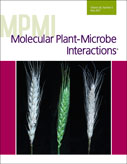 April 2017
April 2017
The Plant-Dependent Life Cycle of Thecaphora thlaspeos: A Smut Fungus Adapted to Brassicaceae
View Article
Biotrophic smut fungi cause diseases of important crops such as maize, wheat, and potato. Frantzeskakis and colleagues introduce a model pathosystem for plant–smut interactions involving Thecaphora thlaspeos, which can infect plants in the genus Arabidopsis.
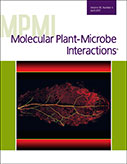 March 2017
March 2017
Below-Ground Attack by the Root-Knot Nematode Meloidogyne graminicola Predisposes Rice to Blast
View Article
Kyndt and colleagues demonstrate that nematode infestation of rice roots can promote above-ground infection by the rice blast pathogen. The mechanism involves auxin and disregulated oxidative stress responses.
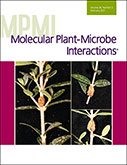 February 2017
February 2017
Fall Armyworm-Associated Gut Bacteria Modulate Plant Defense Responses
View Article
Acevedo and colleagues identified bacterial isolates in oral secretions from the fall armyworm (Spodoptera frugiperda) and demonstrated that bacteria can differentially modulate host responses in different host species.
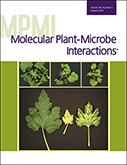 January 2017
January 2017
Perturbation of H3K27me3-Associated Epigenetic Processes Increases Agrobacterium-Mediated Transformation
View Article
Improving the efficiency of Agrobacterium-mediated transformation remains a major challenge for many plant species, particularly if the full potential of genome editing is to be realized. Iwakawa et al. provide evidence that transformation efficiency could be enhanced through manipulation of H3K27me3-dependent epigenetic regulation.
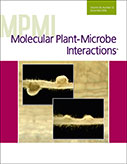 December 2016
December 2016
GABA Uptake Represses Gene Expression in Pseudomonas syringae pv. tomato DC3000
View Article
McCraw et al. demonstrate that the GABA permease GabP provides the primary mechanism for GABA uptake by DC3000 and that a gabP deletion mutant is insensitive to GABA-mediated-repression of T3SS expression.  Open Access.
Open Access.
November 2016
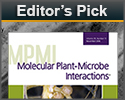 An Immuno-Suppressive Aphid Saliva Protein Is Delivered into the Cytosol of Plant Mesophyll Cells During Feeding
An Immuno-Suppressive Aphid Saliva Protein Is Delivered into the Cytosol of Plant Mesophyll Cells During Feeding
View Article
Mugford and colleagues illustrate how rigorous immunogold labeling experiments can provide definitive information about the subcellular localization of effector proteins. Such information complements functional studies and is critically important for full understanding of effector mode-of-action.
 Open Access.
Open Access.
October 2016
 Blue Light Perception by Roots and Rhizobia Inhibits Nodule Formation in Legumes
Blue Light Perception by Roots and Rhizobia Inhibits Nodule Formation in Legumes
View ArticleExposure of roots to light can inhibit nodulation in
Lotus japonicus. Shimomura and colleagues demonstrate that blue light inhibits nodulation in
L. japonicus roots inoculated with
Mesorhizobium loti and identify photoreceptors from both partners that contribute to this response.
September 2016
Bacillus mojavensis RRC101 Lipopeptides Provoke Changes During Antagonism Against Fusarium verticillioides
 View Article
View Article
Blacutt et al. explore molecular interactions between the maize-endophytic bacterium Bacillus mojavensis and the mycotoxigenic fungus Fusarium verticillioides. Bacterial lipopeptides are implicated in both antifungal activity and fungal toxin production.
August 2016
Arabidopsis Proline Dehydrogenase Contributes to Flagellin-Mediated PAMP-Triggered Immunity by Affecting RBOHD
 View Article
View Article
Fabro and colleagues examine how processes that alter the mitochondrial electron transport chain (mETC) influence establishment of PAMP-triggered immunity (PTI) with emphasis on the effect of the enzyme proline dehydrogenase.
July 2016
Poplar–Root-Knot Nematode Interaction: A Model for Perennial Woody Species
 View Article
View Article
Baldacci-Cresp and colleagues describe a new system for studying interactions between root-knot nematodes and trees. Nematodes exercised conserved strategies to reproduce and invade perennial plants, and poplar was identified as a model host for studying traits of tree–nematode interactions.
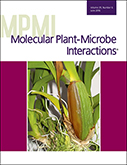 June 2016
June 2016
Peptidoglycan-Remodeling Enzyme Critical for Bacteroid Differentiation in Bradyrhizobium spp. During Legume Symbiosis
View Article
Gully and colleagues provide an elegant genetic demonstration of the important role played by the bacterial peptidoglycan layer in the symbiosis between Bradyrhizobium and Aeschynomene species of legumes.
May 2016
Genome-Wide Association Study (GWAS) Identifies Novel Candidate Genes in Natural Field Populations of Fusarium graminearum
 View Article
View Article
Talas et al. use GWAS and phenotyping under field conditions to identify candidate genes associated with aggressiveness, mycotoxin production, and fungicide resistance in the head blight pathogen, Fusarium graminearum.
April 2016
Phytopathogen Genome Announcement: Draft Genome Sequences of 62 Pseudomonas syringae Type and Pathotype Strains
 View Article
View Article
Thakur and colleagues announce the availability of draft genomes for 62 strains of the bacterium Pseudomonas syringae, a diverse species-complex that affects many important crops. These genomes will be valuable resources for exploring many aspects of bacterial phytopathology.
March 2016
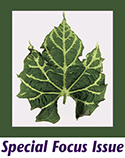 Characterization of RNAi-Transgenic Tomato Plants with Resistance to Tomato Yellow Leaf Curl Virus (TYLCV)
Characterization of RNAi-Transgenic Tomato Plants with Resistance to Tomato Yellow Leaf Curl Virus (TYLCV)
View Article
Fuentes and colleagues describe the benefits and limitations of a transgenic approach for RNAi-based protection against TYLCV. They demonstrate that resistance in transgenic tomato is stable over multiple generations and effective under field conditions. Importantly, they also use transcriptomics to discover probable off-target effects of the transgene.
February 2016
Reduced Susceptibility to Xanthomonas citri in Transgenic Citrus
 View Article
View Article
Transgenic expression of pattern-recognition receptors holds great promise as a tool for enhancing disease resistance in crops. Hao et al. demonstrate the utility of this approach against the citrus pathogen Xanthomonas citri. Overexpression of the FLS2 gene from Nicotiana benthamiana enhanced flg22 responsiveness and pathogen resistance in Hamlin sweet orange and Carrizo citrange.
January 2016
Role of Cytokinin in Infection of Arabidopsis Lines by the Cyst Nematode
View Article
 Shanks et al. used Arabidopsis mutants and transcriptomics to examine the role of cytokinin in infection by Heterodera schachtii. Both nematode infection and parasitism were impaired in Arabidopsis lines with reduced cytokinin sensitivity. These findings suggest that H. schachtii must strike a delicate balance between activating cytokinin signaling to a level sufficient to promote parasitism and avoiding a level high enough to trigger an immune response.
Shanks et al. used Arabidopsis mutants and transcriptomics to examine the role of cytokinin in infection by Heterodera schachtii. Both nematode infection and parasitism were impaired in Arabidopsis lines with reduced cytokinin sensitivity. These findings suggest that H. schachtii must strike a delicate balance between activating cytokinin signaling to a level sufficient to promote parasitism and avoiding a level high enough to trigger an immune response.
December 2015
Evidence of Trade-Offs Between Blast Resistance and Yield in Rice
 View Article
View Article
Wang et al. evaluated agronomic traits and resistance to Magnaporthe oryzae in 151 resistant cultivars and used genome-wide association analysis to delineate loci for resistance and agronomic traits. Their analysis revealed loci for blast resistance and demonstrated that resistance is associated with shorter plants and reduced seed weight.
Jane Glazebrook, Editor-in-Chief
2013-2015
November 2015
Genome Sequence and Architecture of the Tobacco Downy Mildew Pathogen
View Article
 Oomycete pathogens cause a number of important plant diseases. While genome sequence are available for a number of them, there are few sequences from the downy mildews. In this issue, Derevnina and colleagues provide high-quality sequences for two isolates of Peronospora tabacina. They define a set of likely pathogenicity genes for further study, and show that despite the phenotypic variation among oomycetes, there is extensive synteny among the genomes.
Oomycete pathogens cause a number of important plant diseases. While genome sequence are available for a number of them, there are few sequences from the downy mildews. In this issue, Derevnina and colleagues provide high-quality sequences for two isolates of Peronospora tabacina. They define a set of likely pathogenicity genes for further study, and show that despite the phenotypic variation among oomycetes, there is extensive synteny among the genomes.
Chinese translation courtesy of You Lu, University of Minnesota
卵菌病原菌是造成多种重要的植物性疾病的元凶 。虽然一些卵菌的基因组序列已经公布,但是目前对卵菌中霜霉病菌的基因组却知之甚少。 在本月期刊中,Derevnina及同事提供了两株烟草霜霉菌(Peronospora tabacina)的高质量基因组序列。他们给出了一组可能致病基因用于进一步研究,同时展示了这些卵菌基因组存在广泛的同线性,尽管这些卵菌间存在较大的表型差异。
October 2015
Comparative Genomics Reveals Singularities of Two Biocontrol Strains of Bacillus amyloliquefaciens
 View Article
View Article
Controlling diseases using beneficial bacteria is a promising strategy for environmentally friendly agriculture. Magno-Pérez-Bryan and colleagues report the genome sequences of two effective Bacillus amyloliquefaciens strains, implicating production of multiple secondary metabolites and efficient biofilm formation as important factors in biocontrol.
Chinese translation courtesy of You Lu, University of Minnesota
利用有益细菌进行虫害和病害防治是发展环保型农业一种很有前景的策略。在本月期刊中,Magno-Pérez-Bryan及同事报道了两株高效的解淀粉芽孢杆菌(Bacillus amyloliquefaciens)菌株的基因组序列。他们的分析推测出解淀粉芽孢杆菌产生的多种次级代谢产物以及生物被膜的形成对其用于生物防治的特性有重要作用。
September 2015
Reducing Antifungal Activity and Enhancing Fungal Virulence in Tomato
View Article
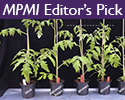 It has long been known that plants produce chitinases during immune responses. These have been thought to play important roles in deterring fungal pathogens, as fungal cell wall contain chitin. In this issue, Jashni et al. show that Fusarium oxysporum f. sp. lycopersici produces enzymes that cleave chitinases produced by its tomato host. Fungal mutants lacking these enzymes have reduced vriulence, demonstrating the importance of tomato chitinase activity in immunity.
It has long been known that plants produce chitinases during immune responses. These have been thought to play important roles in deterring fungal pathogens, as fungal cell wall contain chitin. In this issue, Jashni et al. show that Fusarium oxysporum f. sp. lycopersici produces enzymes that cleave chitinases produced by its tomato host. Fungal mutants lacking these enzymes have reduced vriulence, demonstrating the importance of tomato chitinase activity in immunity.
Chinese translation courtesy of You Lu, University of Minnesota
长久以来已知植物在免疫反应过程中产生多种几丁质酶。这些几丁质酶被认为对植物抵御真菌病原菌起到重要作用,因为几丁质是真菌细胞壁的组成成分之一。在本月期刊中,Jashni及同事展示了番茄尖孢镰刀菌(Fusarium oxysporum f. sp. lycopersici)分泌多种酶用以降解寄主番茄产生的几丁质酶。而无法分泌这些酶的缺陷型真菌突变体的致病性相应降低,表明了番茄几丁质酶对提供免疫能力起到重要作用。
August 2015
RXLR Effector Gene Avrblb2 and Virulence of Phytophthora infestans
View Article
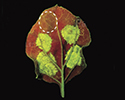 Resistance gene Rpi-blb2 is broadly effective against Phytophthora infestans in potato, whereas Avrblb2, a known allele of the cognate effector, evades detection. In the August issue, Oliva and colleagues report their extensive analysis of the Avrblb2 gene family. They found that Avrblb2 is present in multiple copies and types in P. infestans isolates, which suggests that expansion of this family contributes to pathogen fitness.
Resistance gene Rpi-blb2 is broadly effective against Phytophthora infestans in potato, whereas Avrblb2, a known allele of the cognate effector, evades detection. In the August issue, Oliva and colleagues report their extensive analysis of the Avrblb2 gene family. They found that Avrblb2 is present in multiple copies and types in P. infestans isolates, which suggests that expansion of this family contributes to pathogen fitness.
May 2015
The Development of Symbiosomes in Infected Cells of Medicago truncatula Root Nodules
View Article
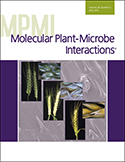 Actin networks are critical for maintaining integrity and subcellular organization of eukaryotic cells. In this issue, Gavrin and colleagues show that rhizobial symbiosomes in nitrogen-fixing legume root nodules are surrounded by nets of actin microfilaments. The ARP3 protein, known to be required for formation of microfilament branches, is also required for proper symbiosome development, demonstrating the importance of actin microfilaments in symbiosome development.
Actin networks are critical for maintaining integrity and subcellular organization of eukaryotic cells. In this issue, Gavrin and colleagues show that rhizobial symbiosomes in nitrogen-fixing legume root nodules are surrounded by nets of actin microfilaments. The ARP3 protein, known to be required for formation of microfilament branches, is also required for proper symbiosome development, demonstrating the importance of actin microfilaments in symbiosome development.
Spanish translation courtesy of Diana Trujillo, University of Minnesota
Las redes de actina son necesarias para mantener la integridad y organización subcelular de células eucariotas. En esta edición, Gavrin y sus colegas muestran que las redes de microfilamentos de actina rodean a los simbiosomas con rizobios dentro de nódulos de raíces en plantas leguminosas fijadoras de nitrógeno. La proteína ARP3, la cual es requerida para la formación de ramas de microfilamentos, también se requiere para el desarrollo adecuado de los simbiosomas, demostrando la importancia de microfilamentos de actina en el desarrollo de los simbiosomas.
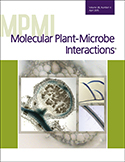 April 2015
April 2015
Salicylic Acid and the Replication of Tomato bushy stunt virus
View Article
Salicylic acid (SA) is well known as a plant hormone involved in plant defense signaling, but the mechanisms by which it protects plants are less well understood. In the April issue, Tian et al. show that SA contributes to resistance against Tomato bushy stunt virus by binding directly to Arabidopsis glyceraldehyde 3-phosphate dehydrogenase, a host protein needed for viral replication.
March 2015
Similar Effector Repertoires Between Pathogenic and Saprophytic Verticillium Species
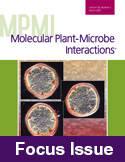 View Article
View Article
Given the rapidly increasing capacity for sequencing, as well as the decreasing cost, comparing the genomes of multiple strains and species has become an effective approach for uncovering genomic features that potentially underpin specific traits or ecological niches. In the March Focus Issue on genomics, Seidl et al. compare the gene repertoire and genome organization of Verticillium tricorpus with those of two pathogenic relatives: V. dahliae and V. alfalfae. These species encode similar putative effectors; thus, a key question is what functions these proteins confer.
February 2015
A New Component of the Type III Secretion System
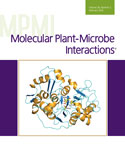 View Article
View Article
Transport of effector proteins from bacterial pathogens into host cells is crucial for pathogen virulence. In gram-negative bacteria, transport occurs through the specialized type III secretion system. In the February issue, Xiaofeng Zhou and colleagues demonstrate that the protein VrpA—an essential virulence factor for Xanthomonas spp.—is required for efficient protein secretion via the type III secretion system and that it localizes to the bacterial periplasmic space. These findings expand the mechanical understanding of this important secretory process in Xanthomonas spp.
Spanish translation courtesy of Diana Trujillo, University of Minnesota
El transporte de proteínas efectoras de bacterias patogénicas hacia el interior de células huésped es crucial para la virulencia de patógenos. En las bacterias gram negativas, el transporte ocurre a través del sistema de secreción tipo III, especializado para este propósito. En la edición de febrero, Xiaofeng Zhou y sus colegas demuestran que la proteína VrpA, un factor de virulencia esencial para Xanthomonas spp., es necesaria para la secreción eficiente de proteínas a través del sistema de secreción tipo III y que se localiza en el espacio periplásmico de las bacterias. Estos resultados ayudan a entender el funcionamiento mecánico de este proceso de secreción importante para Xanthomonas spp.
Chinese translation courtesy of You Lu, University of Minnesota
效应子蛋白从致病细菌向寄主细胞中的转运对病原菌毒力至关重要。在革兰氏阴性细菌中,转运通过特化的III型分泌系统进行。在二月份期刊中,Xiaofeng Zhou和同事发现了一个存在于多种黄单胞杆菌属 (Xanthomonas) 细菌周质空间的关键毒力因子VrpA,是细菌通过III型分泌系统有小弟进行蛋白分泌所必须的。这些发现拓展了对这种在黄单胞杆菌属细菌中重要的分泌过程的机理性的认知。
January 2015
Fungal MAP Kinase Cascade Crucial for Symbiosis
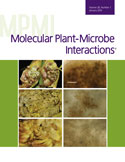 View Article
View Article
The fungus Epichloë festucae is a mutualistic symbiont of the grass Lolium perenne. In the January issue, Becker et al. report on using a forward genetic screen and finding that mutations in the cell-wall integrity MAP kinase cascade cause symbiotic defects, including increased proliferation of hyphae, early senescence of the host, and colonization of the vasculature. These results show that the cell-wall integrity MAP kinase cascade plays a key role in control of the symbiotic development of the fungus.
Spanish translation courtesy of Diana Trujillo, University of Minnesota
El hongo Epichloë festucae es un simbionte mutualista de la hierba Lolium perenne. En la edición de enero, Becker et al. usaron técnicas de genética directa y encontraron que mutaciones en la cascada de MAP quinasas para integridad de la pared celular causan defectos simbióticos, incluyendo un aumento en la proliferación de hifas, senescencia temprana del huésped y colonización de la vasculatura. Estos resultados demuestran que la cascada de MAP quinasas para la integridad de la pared celular juega un papel clave en el control del desarrollo simbiótico del hongo.
Chinese translation courtesy of You Lu, University of Minnesota
羊茅香柱菌(Epichloë festucae)是多年生黑麦草(Lolium perenne)的一种共生真菌。在1月份期刊中,Becker及同事报道了运用正向遗传学筛选发现了细胞壁结构完整性MAP激酶级联反应途径的突变导致共生作用的缺陷,包括真菌菌丝增生,寄主早衰,以及在维管组织中定植。这些实验结果表明细胞壁结构完整性MAP激酶级联反应途径在控制这种真菌的共生生长过程中起到关键作用。
December 2014
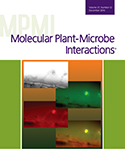 Phytophthora Suppressors of RNA Silencing
Phytophthora Suppressors of RNA Silencing
View Article
Phytophthora species produce hundreds of effector molecules, so it has been difficult to determine which ones are important for virulence and what their activities are. In the December issue, Xiong et al. demonstrate that one of these effectors, which is conserved among Phytophthora species, interferes with RNA silencing systems in the host and substantially promotes virulence. In addition to demonstrating the function of an important Phytophthora effector, this work shows that host RNA silencing systems interfere with Phytophthora virulence.
Spanish translation courtesy of Diana Trujillo, University of Minnesota
Especies de Phytophthora producen cientos de moléculas efectoras, por lo que ha sido difícil determinar cuáles de éstas son importantes para la virulencia y cuáles son las actividades de estas moléculas. En esta edición, Xiong et al. demuestran que uno de estos efectores, el cual es conservado entre especies de Phytophthora, interfiere con sistemas de silenciamiento de RNA en el huésped y promueve la virulencia. Además de mostrar la función de un importante efector de Phytophthora, este trabajo muestra que los sistemas de silenciamiento de RNA del huésped interfieren con la virulencia de Phytophthora.
Chinese translation courtesy of You Lu, University of Minnesota
疫霉属 (Phytophthora)致病菌可以产生数百种效应子分子,因此一直以来分析出哪些效应子对致病性有重要作用以及它们的活性是很困难的。在本月期刊中,Xiong及同事展示了其中一个疫霉属致病菌中共有的效应子可以干扰寄主中的RNA沉默系统,并极大地促进致病性。除了证实此疫霉属致病菌效应子的功能外,这项研究还表明了寄主的RNA沉默系统能够抑制疫霉属致病菌的毒性。
November 2014
A SWEET Sugar Transporter in Cassava
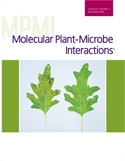 View Article
View Article
A Xanthomonas pathogen of rice produces transcription activator-like (TAL) effectors that activate expression of SWEET sucrose exporters in the host, providing a carbon source for the pathogen. In the November issue, Cohn and colleagues present a comprehensive study showing that Xanthomonas pathogens of cassava also produce TAL effectors critical for virulence that activate expression of a sucrose and glucose exporter. This work provides a strategy for engineering Xanthomonas resistance in cassava, an important food crop.
Chinese translation courtesy of You Lu, University of Minnesota
一种黄单胞菌属中的水稻病原菌产生类转录激活因子(TAL)效应物来激活寄主中SWEET蔗糖外排转运蛋白的基因表达,为病原菌提供碳源。在11月份期刊中,Cohn和同事报道了一项详尽的研究表明黄单胞菌属中的木薯病原菌同样产生决定其致病性的TAL效应物来激活一个蔗糖和葡萄糖外排转运蛋白的基因表达。这个研究为作为重要食用作物的木薯进行黄单胞菌抗性的工程改造提供了一项策略。
October 2014
A Fungal Conserved Gene and Efficient Ectomycorrhiza Formation
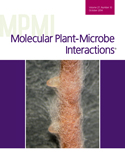 View Article
View Article
Although ectomycorrhizal symbioses are widespread and important for plant health in many ecosystems, little is known about the genetic requirements for fungal differentiation during mycorrhizal development. In the October issue, Doré and colleagues report T-DNA mutagenesis of the basidiomycete Hebeloma cylindrosporum, resulting in identification of the gene HcMycE1. Disruption of this gene blocks fungal ability to differentiate fungal sheath and Hartig net structures. Identifying HcMycE1 sets the stage for genetic dissection of the fungal side of ectomycorrhizal symbioses.
Spanish translation courtesy of Diana Trujillo, University of Minnesota
Aunque las simbiosis ectomicorrizas son prevalentes e importantes para la salud de las plantas en muchos ecosistemas, se sabe poco acerca de los requisitos genéticos para la diferenciación de hongos durante el desarrollo de micorrizas. En la edición de octubre, Doré y sus colegas reportan la mutagénesis por T-DNA del basidiomiceto Hebeloma cylindrosporum, resultando en la identificación del gen HcMycE1. La interrupción de este gen bloquea la habilidad del hongo de diferenciarse en mantos fúngicos y redes de Hartig. La identificación de HcMycE1 prepara el escenario para la disección genética del lado fúngico en las simbiosis ectomicorrizas.
Chinese translation courtesy of You Lu, University of Minnesota
虽然外生菌根共生现象是非常普遍的,并且在许多生态系统中对植物的健康有重要作用,但是目前对在菌根发育过程中真菌分化所必需的基因却知之甚少。在十月份期刊中,Doré和同事报道了通过对担子菌门真菌Hebeloma cylindrosporum进行T-DNA诱变的方法鉴定出了HcMycE1基因。破坏该基因导致真菌无法分化出菌鞘和哈蒂氏网结构。鉴定HcMycE1基因对外生菌根共生中真菌层面的遗传剖析奠定了基础。
September 2014
Tomato ringspot virus Coat Protein
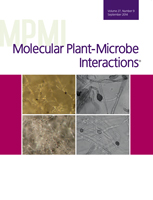 View Article
View Article
RNA silencing provides a potent defense against plant viruses; however, most viruses encode suppressor proteins that inhibit one or more steps in the silencing pathway. Several viral RNA-silencing suppressors inhibit Argonaute (AGO) 1, but until now, only inhibition of AGO1-mediated RNA degradation has been observed. In the September issue, Karran and Sanfaçon report that the coat protein of Tomato ringspot virus appears to protect viral RNA from AGO1-mediated inhibition of translation.
Spanish translation courtesy of Diana Trujillo, University of Minnesota
El silenciamiento por RNA en plantas es un mecanismo de defensa importante contra los virus de plantas. Sin embargo, la mayoría de virus de plantas producen proteínas supresoras del silenciamiento por RNA, e inhiben una o más etapas en las vías de silenciamiento. Varios de estos supresores virales inhiben Argonauta 1 (AGO1), pero hasta ahora solamente se ha observado la inhibición de la degradación de ARN mediada por AGO1. En esta edición, Karran y Sanfaçon reportan que la proteína de cubierta del virus de las manchas anulares del tomate parece más bien proteger al ARN viral contra la inhibición de traducción mediada por AGO1.
Chinese translation courtesy of You Lu, University of Minnesota
RNA沉默是一种植物抵御病毒的有效途径。然而,大部分植物病毒编码RNA沉默抑制因子蛋白来抑制沉默途径中的一步或多步。几种病毒编码的RNA沉默抑制因子抑制Argonaute 1 (AGO1),不过目前仅观察到其对AGO1介导的RNA降解的抑制作用。在本月期刊中Karran和Sanfaçon报道了番茄环斑病毒的外壳蛋白表现出对病毒RNA的保护,使其免受AGO1介导的翻译抑制作用的影响。
August 2014
Endo-Arabinanase BcAra1 Is Novel Host-Specific Virulence Factor of Botrytis cinerea
View Article
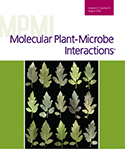
The fungal necrotroph Botrytis cinerea is known to require enzymes that degrade host cell walls for its virulence, but degradation of arabinan was not known to be important to the process. In comprehensive work published in the August issue, Nafisi et al. demonstrate that B. cinerea produces an arabinanase, that the encoding gene is induced during infection, and that the gene is required for full virulence on Arabidopsis thaliana. Interestingly, arabinanase is expressed at lower levels during infection of other hosts and in these cases is not required for virulence, indicating the pathogen's ability to adapt its mode of attack to a particular host.
Spanish translation courtesy of Diana Trujillo, University of Minnesota
La virulencia del hongo necrótrofo Botrytis cinerea depende de enzimas que degradan la pared celular de su huésped. Sin embargo, la importancia de la degradación de arabinano no se conocía aún. En la investigación publicada en este número, Nafisi et al. demuestran que Botrytis cinerea produce una arabinanasa, que el gen que codifica esta enzima es inducido durante la infección y que se requiere esta enzima para la virulencia completa en Arabidopsis thaliana. Curiosamente, la arabinanasa se expresa a nivel más bajo durante la infección en otros huéspedes, y en estos casos no se requiere para la virulencia, lo cual indica una capacidad del patógeno para adaptar su modo de ataque según su huésped.
Chinese translation courtesy of You Lu, University of Minnesota
现已知,死体营养型真菌灰霉病菌(Botrytis cinerea)的致病性依赖于降解寄主细胞壁的酶。然而,聚阿拉伯糖降解的重要性尚未研究透彻。在发表于本月期刊的一项全面的研究中,Nafisi和同事证实了灰霉病菌产生一种聚阿拉伯糖酶,其编码基因在侵染过程中被诱导表达,并且这种酶也是对拟南芥高致病性所必需的。有趣的是,在侵染其它寄主的过程中,聚阿拉伯糖酶处于较低的表达水平,并且不影响对这些寄主的致病性,这表明了该病原菌能够适应针对特定寄主的攻击模式。
July 2014
Metabolic Environments and Genomic Features Associated with Pathogenic and Mutualistic Interactions Between Bacteria and Plants
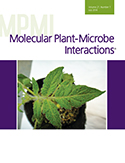 View Article
View Article
Comparative analyses of microbial genomic sequences can highlight genomic traits that may function as hallmarks of specific microbial lifestyles. In the July issue, Karpinets and colleagues report on coupling comparative genomics with metabolic network models to identify genomic traits associated with pathogenic versus mutualistic interactions with plants. These genomic hallmarks, which include a putative secretion system in pathogens and a putative RuBisCO-based metabolic pathway in mutualists, were successful in predicting the pathogenic versus mutualistic interactions of 20 recently sequenced microbes.
Spanish translation courtesy of Diana Trujillo, University of Minnesota
Análisis comparativos de secuencias genómicas microbianas pueden resaltar rasgos genómicos que posiblemente funcionen para distinguir entre diversos estilos de vida de los microorganismos. En esta edición, Karpinets y sus colegas usaron técnicas de genómica comparativa conjunto con modelos de redes metabólicas para identificar rasgos genómicos asociados a interacciones patogénicas versus mutualistas con plantas. Usando estas características genómicas, que incluyen un sistema de secreción putativo en patógenos y una vía metabólica putativa basada en RuBisCO en mutualistas, fue posible predecir entre interacciones patogénicas y mutualistas en veinte microbios secuenciados recientemente.
Chinese translation courtesy of You Lu, University of Minnesota
微生物基因组序列的对比分析可以突显其基因组特征,这些特征可能作为微生物的特定生存方式的标志。在本月期刊中,Karpinets和同事结合比较基因组学和代谢网络模型的分析鉴定出了与植物致病性和与植物互利共生相关联的基因组特征。这些基因组的标志,其中包括一个在病原菌中潜在的分泌系统和一个在共生菌中潜在的基于RuBisCO 的代谢途径,成功地预测了近期被测序的20种微生物的致病性或互利共生相互作用。
June 2014
Knocking Out Bcsas1 in Botrytis cinerea
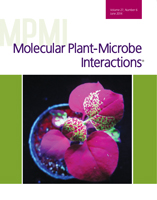 View Article
View Article
Rab/GTPase proteins are known to play important roles in protein secretion in eukaryotes through regulation of vesicle trafficking at multiple steps. In the June issue, Zhang et al. study Bcsas1, a gene that encodes a Rab/GTPase in Botrytis cinerea, and their detailed characterization reveals that Bcsas1 is important for protein secretion. B. cinerea is known to rely on a variety of secreted proteins for virulence. Accordingly, mutants in which Bcsas1 is disrupted exhibit reduced secretion of plant cell wall degrading enzymes and greatly reduced virulence on several host plants.
Spanish translation courtesy of Diana Trujillo, University of Minnesota
Las proteínas Rab/GTPasas juegan papeles importantes en la secreción de proteínas en eucariotas, siendo implicadas en varios pasos de la regulación del tráfico de vesículas. En esta edición, Zhang et al. estudian Bcsas1, un gen que codifica la Rab/GTPasa en Botrytis cinerea. Su caracterización detallada revela que Bcsas1 es importante para la secreción de proteínas. Se conoce que la virulencia de B. cinerea depende de una variedad de proteínas secretadas. En conformidad con lo anterior, mutantes en los que se interrumpe Bcsas1 mostraron una reducción en la secreción de enzimas que degradan la pared celular y una gran reducción en la virulencia de este patógeno en varias plantas huéspedes.
Chinese translation courtesy of You Lu, University of Minnesota
Rab GTP酶因其对囊泡运输的多个环节的调控被认为在真核生物细胞的蛋白分泌过程中起到重要作用。在本月期刊中,Zhang等研究了在灰霉病菌(
Botrytis cinerea)中编码一种Rab GTP酶的
Bcsas1基因。他们对
Bcsas1基因详细的表征特性研究表明该基因在蛋白分泌过程中起到重要作用。灰霉病菌的致病性已知依赖于多样的分泌蛋白。相应地,
Bcsas1基因缺陷型菌株的植物细胞壁降解酶的分泌量有所减少,并且很大程度地削弱了其对寄主植物的致病性。
May 2014
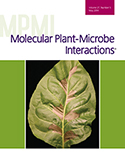 Herbivore Cues from Fall Armyworm Larvae Trigger Direct Defenses in Maize
Herbivore Cues from Fall Armyworm Larvae Trigger Direct Defenses in Maize
View Article
Saliva from caterpillars has been shown to trigger defense responses in dicot plants. In the May issue, Chuang et al. show that saliva from the fall armyworm triggers defenses in a monocot: maize. The researchers used an elegant system that included caterpillars able and unable to secrete saliva, thus ensuring the biological relevance of the results. Feeding by intact caterpillars was found to induce defenses that inhibit caterpillar growth, whereas feeding by impaired caterpillars did not have this effect.
Spanish translation courtesy of Diana Trujillo, University of Minnesota
Se conoce que la saliva de las orugas puede estimular respuestas de defensa en plantas dicotiledóneas. En esta edición, Chuang et al muestran que la saliva del gusano cogollero induce defensas en un monocotiledóneo, el maíz. Ellos usaron un sistema elegante incluyendo orugas intactas y orugas sin capacidad de secretar saliva, así asegurando la relevancia biológica de sus resultados. Demuestran que alimentación por parte de orugas intactas induce defensas que inhiben crecimiento de orugas, mientras que alimentación por orugas que no secretan saliva no tiene este efecto.
Chinese translation courtesy of You Lu, University of Minnesota
现已知毛虫的唾液可以在双子叶植物中诱导免疫反应。在本月期刊中,Chuang等发现草地贪夜蛾毛虫的唾液在单子叶植物玉米中同样诱导免疫反应。他们使用了一套设计精巧的系统,包括健全的毛虫和无法分泌唾液的毛虫,来确保其结果的生物相关性。他们展示了健全毛虫的进食会诱导植物产生抵御以抑制毛虫的生长,而无法分泌唾液的毛虫进食时并没有此效应。
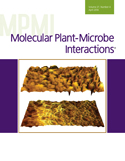 April 2014
April 2014
Melanin and the Corn Pathogen Colletotrichum graminicola
View Article
Melanin is required for the successful penetration of leaf surfaces by fungal appressoria, but the nature of this requirement is not entirely clear. In the April issue, Ludwig and colleagues use a melanin-deficient mutant of Colletotrichum graminicola to demonstrate that melanin is not needed for appressoria to generate turgor pressure and penetrate ultrathin synthetic membranes. Rather, melanin provides the cell-wall strength needed for penetration of intact leaves.
Spanish translation courtesy of Diana Trujillo, University of Minnesota
La melanina es necesaria para una penetración exitosa de los apresorios de hongos en superficies de hojas, pero la naturaleza de este requerimiento no se conoce del todo. En la edición de abril, Ludwig y sus colegas usan un mutante de Colletotrichum gramnicola deficiente en melanina para demostrar que la melanina no es requerida para que los apresorios generen presión de turgencia y penetren membranas sintéticas ultradelgadas. Más bien, la melanina suministra la fuerza a la pared celular que se requiere para penetración de hojas intactas.
Chinese translation courtesy of You Lu, University of Minnesota
黑色素是真菌附着胞成功穿透植物叶片表层所必须的,但是黑色素在此过程中的作用尚未研究透彻。在4月刊中,Ludwig等用一株黑色素缺乏的炭疽病菌Colletotrichum graminicola的突变菌株证实了黑色素并非用于在附着胞中产生膨压以穿透超薄合成膜,而是用于增强附着胞的细胞壁刚度来穿透完整的植物叶片。
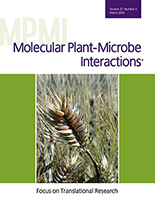 March 2014
March 2014
Effectors as Tools in Disease Resistance Breeding
View Article
Pathogen effectors are molecules that contribute to virulence through suppression of host defense responses and other activities. In the March Focus Issue on Translational Research, Vleeshouwers and Oliver describe successful strategies for exploiting pathogen effectors to breed more resistant crops. This approach of turning the pathogen's own weapons against it will likely have broad application. Reading this review is essential for anyone interested in improving disease resistance in crops.
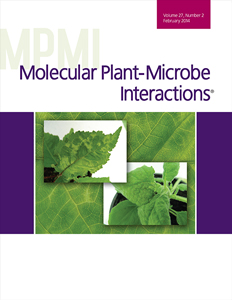 February 2014
February 2014
Open Access Spotlight Article: Two Distinct EF-Tu Epitopes Induce Immune Responses in Rice and Arabidopsis
View Article
Plants recognize potentially pathogenic microbes using receptor-like kinases that bind conserved microbial molecules. One of these molecules, bacterial elongation factor TU (EF-Tu), was thought to be recognized only by Brassicaceae, which respond to an 18-amino acid epitope known as elf18. In this issue, Furukawa and colleagues show that rice also recognizes EF-Tu, but responds to a different epitope. EF-Tu is highly conserved and is one of the most abundant proteins in bacterial cells. Rice and the Brassicaceae apparently have taken different evolutionary paths to recognition of this molecule.
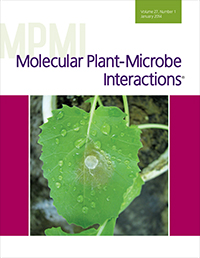 January 2014
January 2014
Kinases and Signal Transduction in Tomato and Solanaceae Species
View Article
Protein kinases are critical components of plant immunity. In the January issue, Singh et al. report development of a comprehensive system for studying protein kinases of tomato. The system includes full-length expression clones, an improved protoplast transient expression system, and a protein chip for detection of proteins that interact with kinases. The authors demonstrate the power of this system by using it to discover a kinase targeted by an effector from the pathogen Pseudomonas syringae.
